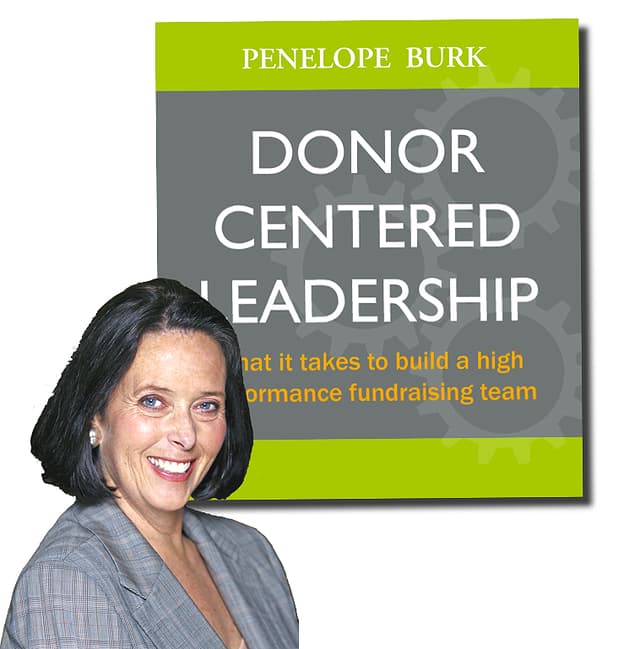Could this be the sea change that fundraising really needs?
- Written by
- Penelope Burk
- Added
- August 09, 2013
Book review

Donor–Centred Leadership: what it takes to build a high-performance fundraising team by Penelope Burk.
Reviewed for SOFII by Ken Burnett.
Game-changing books don’t come along often, so this could be the most important book about fundraising that you’ll buy in what, as Penelope Burk comprehensively illustrates, is likely to be your all-too-short and under-fulfilled career. That said, maybe you should invest in more copies, one each for your board and senior management team, then spread them around as compulsory reading, the first vital step towards bringing about – in your not-for-profit at least – the sea change that fundraising really needs.
Donor-Centred Leadership is a work of Herculean proportions and it’s well written too. Across 364 pages it outlines every aspect of the effective fundraising office explaining why fundraising departments so often fall short of achieving their potential. The subjects this book explores form the core of what fundraising leaders everywhere will have to address if we’re ever to fix our broken system and put right the debilitating paradox that is the not-for-profit sector’s rampant staff turnover. How can it be that the business sector charged with changing the world for the better can’t hold on to its best people?
Incredible, intolerable though it is, that’s the problem. Yet this book explains how we might put it right. Of course, we can only give you the merest taste of its riches in this short review.
From what Penelope Burk and her colleagues have uncovered in the process of preparing Donor-Centred Leadership, it seems that senior management teams and boards who get their fundraising even close to right are in a dangerously declining minority. Just as well then that this book has come along in the nick of time to help you turn things round in your enterprise.
According to its author the book is the culmination of five years of research with over 12,000 professional fundraisers, not-for-profit CEOs, leadership volunteers and donors. Donor-Centred Leadership’s advice on how to build and sustain a high performance fundraising team is, the author tells us, built on observations from their critical vantage points on the front lines of fundraising and philanthropy.
So, people who should know. And the insights they give cover the key aspects of that team building, from the raw fundamentals to some new takes that you’ll find surprising.
People give to (quality) people

People give to people is an old adage, and some might say a tired one, but it’s still undeniably true. Ms Burk puts her take on it rather well.
‘The quality of human interaction, customer service, donor relations – how one person treats and interacts with another – underpins all business success. And, when you’re selling an intangible, an optional commodity, in fact one that will not even be consumed by the purchaser, the quality of people-to-people interaction is the glue that binds donor to not-for-profit. In a field where building relationships is key and where its practitioners acknowledge that doing so takes time, finding and holding onto good fundraisers is as integral to profit as finding and holding onto donors.’
Just think about that. The quality of our people is the glue that binds donors to our organisation. Keeping them is as important as keeping donors. Should we not be better at looking after an investment of that significance? Ms Burk goes on to say,
‘The length of time professional fundraisers stay with one not-for-profit is a bellwether of the industry. And, on that front, there seems to be trouble. Nine out of ten development directors feel that the rate of turnover in their organisations is a problem and over half of CEOs have experienced the premature resignation or dismissal of their head fundraiser.’
The author paints a picture of an under-resourced sector whose people are easily seduced away. She cites development directors, ‘Six months in post before they get their first offer, less than a year before courtship begins.’
A fundraising bonanza awaits
Why should we work harder at keeping our people? This seems a no-brainer.
‘…adding 12 more months to the tenure of a non-management staff member, who had planned to leave after one year on the job, saves his not-for-profit almost 1.2 times his salary for a full year. More important, both employer and employee get to reap the return on their collective investment. The not-for-profit’s time invested up front in training and mentoring now yields a more experienced staff member who, in year two, achieves results faster, solves problems more creatively (or avoids them altogether), and contributes as a fully functioning member of the team. The employee also benefits from living out a more satisfying career experience, rather than cycling through another apprenticeship period. And, when he does leave, he will be a much more valuable commodity to his next employer, while having the satisfaction of knowing he has served his current one well.
‘Extending job tenure along the spectrum of increasingly senior fundraising positions eventually leads to the biggest payoff of all – in planned giving. But, currently, this is where the gap is widest between what could be realized and what fundraisers are actually raising. Among donors who have assigned a bequest in their wills, only four per cent say they were influenced to do so by a representative of the recipient charity. While donors should be lauded for their initiative, fundraisers know that when they play an active role in negotiating major gifts (including planned gifts), more donors give and give more generously than if left to make these decisions on their own.’
The author’s conclusion?
‘A fundraising bonanza is there for the taking.’
She goes on to say,
‘Resourcing fundraising more effectively also means being realistic about the inherent limitations of the business in developing the right kind of talent. Fundraising is comprised of two distinct fields – direct marketing and relationship fundraising – and someone who shines in the former may not be the best candidate for the latter.’
A how-to book with a difference – you really can do this.
I love the down-to-earth practical advice that litters this book:
‘Working through the pain when you have flu by showing up at the office anyway is not heroism; it is disrespect.’
And the alarmingly perceptive insights:
‘There she is – that staff member who is officially in line for your job. She’s watching you get older; she’s monitoring your every move; she’s adding up your mistakes. She’s so cool about it all, too, just biding her time till you leave... or get pushed out...or drop dead on the job. Perhaps she’s even nudging things along a little. After all, that banana peel on the floor beside your desk didn’t just materialize out of nowhere. Better watch out…’
Then there’s self-interest,
‘Think about your top performer – the one you definitely do not want to lose. Imagine her hovering in your doorway now, trying to find the words to tell you she is leaving. Ask yourself what allowances you would make in order to keep her on the job for one more year. Knowing that she will leave twelve months from now, would you finally assign her that meaty project that you know she would handle so well?’
The right priorities
In order to meet the growing demand for professional fundraisers, Penelope Burk suggests that not-for-profit decision-makers need to focus their priorities:
- Address the issues that cause too many experienced professionals to abandon fundraising as a career. Bring new thinking to the table that will inspire them to stay in one place long enough to make a measurable impact.
- Redefine the fundraising job description for leadership volunteers, providing appropriate training and support to help them reclaim the high profile role that donors expect them to play.
- Turn fundraising itself into a more desirable job for professionals and a less daunting task for volunteers and CEOs by bringing its methods in line with donors’ needs and sensibilities.
On the way to explaining how this might be achieved Ms Burk covers, in no particular order, fundraising nirvana, the profit principle, meetings and more meetings (chapter 12 – love that one!), the overtime culture (why fundraisers can’t get their work done in a 35-hour week), holding on to the team you build, time management, overtime and time off, email (the scourge that haunts us all – love it!) plus scary stuff like, ‘let your door do the talking’ and lots more besides. Then, there’s practical, nuts-and-bolts stuff like evaluating your board, learning, investigating and pursuing your dreams… For would-be masters of the fundraising culture, this book’s a cornucopia.
But there’s a big point here. Culture at work is important, valuable and fragile and so many things conspire to upset it. Fundraisers are so polite, they allow those upsets way too often. It’s no exaggerated claim: this book will pay for itself in no time. There’s even some really useful advice on how to structure working hours for staff who have to be on hand during evenings and weekends to meet with donors.
Ms Burk says, ‘Thirty-seven per cent of employee time is spent in meetings. Let’s cut that back to 30 per cent on the assumption that you run a more efficient shop. It’s still costing you…’ (Sorry, I’m running out of space here. You’ll have to buy the book).
As I read through Donor-Centred Leadership (and I do need to start again) I found my alarm and dismay at the scale of our shortcomings being gently assuaged by the practical advices that come along in rapid succession telling me what can be done about this crisis and how. Before long, I grew to be hugely relieved by the book and its content. If ever there was a book that’s timely, transformational and totally essential, this is it.

About Ken Burnett
 Ken Burnett is author ofRelationship Fundraising and other books including The Tiny Essentials of an Effective Volunteer Board (The White Lion Press Limited, London, UK) and The Zen of Fundraising, (Jossey-Bass Inc, San Francisco, USA).
Ken Burnett is author ofRelationship Fundraising and other books including The Tiny Essentials of an Effective Volunteer Board (The White Lion Press Limited, London, UK) and The Zen of Fundraising, (Jossey-Bass Inc, San Francisco, USA).
Ken is also SOFII’s managing trustee.
















